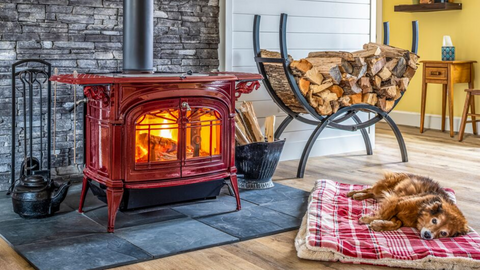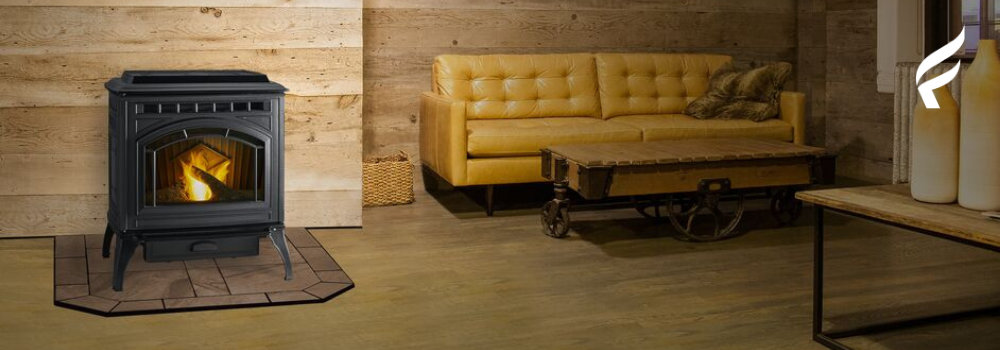As winter approaches, the need for an efficient and dependable home heating solution is urgent, especially for homeowners in regions with harsh winters. For those looking to leverage the most out of their home heating solution, pairing a heat pump with a heating stove is the best of both worlds: unmatched efficiency with a cozy ambiance.
In this blog post, we will examine how incorporating a heating stove can enhance your heating experience.
What are Heating Stoves and Inserts?
Steeped in tradition, heating stoves have been trusted for generations to keep homes warm. These freestanding appliances burn various fuels, such as wood, pellets or gas, to generate much-needed heat. They come in an array of styles and sizes to suit various home setups, including fireplace inserts. Inserts are like stoves, however, instead of standing on four legs or a pedestal on top of a hearth pad, fireplace inserts slide into a fireplace space to add both high efficiency and heat output.
At Forge & Flame, we offer an extensive line of stoves and inserts across three distinguished brands:
Harman:
Vermont Castings:
Quadra-Fire:
What is a Heat Pump?
In contrast, heat pumps offer a contemporary solution to home heating. They function by extracting heat from the external environment during winter and transporting it indoors to provide warmth. Conversely, during the summer, they remove heat from the interior of the house and release it outside. Heat pumps rely on electricity for operation and are renowned for their energy efficiency, making them an excellent choice for environmentally conscious individuals seeking an economical heating solution.
Benefits of Adding a Heating Stove and a Heat Pump to Your Home
Discover the flexibility of heating your home to your needs. With the combination of a heating stove and a heat pump, gone are the days of inefficient, costly heating using oil or gas. This heating solution duo delivers more than just heat, it provides the perfect solution to a warm home.
Add a heating stove and heat pump to enjoy:
A Reliable Heating Solution

As winter temperatures take a plunge, ensuring your home remains a safe and comfortable haven for you and your loved ones becomes a top priority. Fortunately, the combination of heat pumps and heating stoves offers a dependable and versatile solution that adapts seamlessly to varying weather conditions.
While heat pumps are designed for moderate climates and provide consistent warmth, heating stoves step in when facing regions with cold climates. This pairing not only enhances your home's coziness but also acts as a fail-safe mechanism, crucial for countering the unpredictability of winter storms and power outages. Notably, wood stoves are a self-reliant heating source, unaffected by electricity or backup generator requirements.
Both heat pumps and heating stoves boast impressive lifespans ranging from 15 to 20 years, with proper use and maintenance. This longevity provides you with the assurance that your heating system will continue to safeguard your loved ones, keeping them warm and secure for 20 winters to come.
Cost Savings
Fossil fuel prices have experienced significant volatility, particularly in recent years. This rollercoaster of price fluctuations has prompted numerous homeowners to seek out cost-effective and renewable heating alternatives, such as wood and pellet heating stoves, as well as heat pumps.
In the last decade, pellet prices have remained consistent, in stark contrast to the unpredictable fluctuations in other energy sources like gas, propane and oil. This stability has provided homeowners with a reliable option, shielding them from sudden and substantial increases in their heating bills.
A Pennsylvania State University study found that “pellets and cordwood will both result in pretty sizeable savings, relative to fuel oil, in your heating bill. Pellets give the lowest savings, and ‘cut your own’ cordwood gives the greatest savings because it costs the least.” In fact, many areas of the United States are seeing heating oil prices continue to climb to over $5 per gallon, whereas a ton of pellets costs $300. To put these numbers in perspective, a ton of pellets would have to cost $500 to equate to the cost of heating with oil. Furthermore, heat pumps on average save up to $948 annually when replacing heating oil.
An Efficient Energy Source
The efficiency of heating stoves and heat pumps lends numerous benefits: cost savings, sustainable living practices and reliability.
With guidelines in place, all stoves on the market today are EPA-certified, meaning that they adhere to strict emissions and efficiency regulations to ensure the well-being of our planet. These units are likely to fall into the 70 to 80% efficiency range and “have heating capacities that range between 8,000 and 90,000 BTU per hour,” according to the Department of Energy.
However, stove brands such as Quadra-Fire, Harman and Vermont Castings offer many stoves and inserts that exceed these baseline standards, earning those units federal tax credit qualifications. For example, Harman’s PelletPro™ System enables the efficient combustion of pellets of any quality while producing maximum heat output. Its innovative bottom-up feeding mechanism ensures complete pellet consumption, allows for continuous 24-hour heating and consistently maintains the fire temperature within a 1-degree range of the set target, delivering industry-leading performance and efficiency.
Vermont Castings' Flexburn Technology provides you with the freedom to burn with or without a catalyst. When the catalyst is utilized, it delivers an impressive 15% boost in efficiency during low-burn operations. This heightened efficiency not only saves costs but also promotes sustainable living by reducing stove emissions and extracting the maximum heat from each load of wood.
Moreover, according to MIT Technology Review, “heat pumps today can reach 300% to 400% efficiency or even higher, meaning they’re putting out three to four times as much energy in the form of heat as they’re using in electricity.” By pairing both a heat pump and a heating stove, your home will be a comfortable temperature all season long while achieving optimal efficiency.
Sustainable Living
When using renewable fuel sources like wood pellets or logs, heating stoves can be an eco-friendly choice. Homeowners can have peace of mind knowing that their heat directly reduces their carbon footprint and contributes to a more environmentally friendly heating solution. Derived from what otherwise would end up as waste in a landfill, pellets are a renewable resource made from manufacturing byproducts such as scrap wood, debris and sawdust. Like pellets, wood fuel also lends itself to sustainable heating practices as it is a renewable resource—so much so that you can grow your own fuel in your backyard!
The units that extract the heat from the fuel also follow strict regulations. EPA-certified stoves must limit their emissions to only 2 grams of smoke per hour, ensuring minimal carbon output, especially compared to heating with fossil fuels like heating oil and propane.
Heat pumps also operate sustainably to displace carbon dioxide emissions up to 53% over a gas furnace.
Ambient Warmth

Experience the dual benefits of a heat pump's efficiency and the cozy, inviting ambiance provided by a heating stove. These stoves create a warm and welcoming atmosphere in your home, becoming a radiant focal point of any room. By incorporating both a heating stove and a heat pump, you can truly enjoy the perfect blend of alternative home heating solutions.
Next Steps
If you are ready to enjoy the charm and reliability of a heating stove, we invite you to contact one of our local dealers today. Our experts can provide personalized recommendations and guide you toward selecting the perfect heating stove to keep your home cozy and inviting. Embrace the warmth and atmosphere of a heating stove in your home this winter season!


